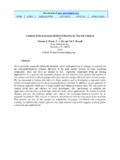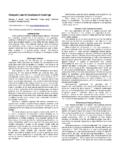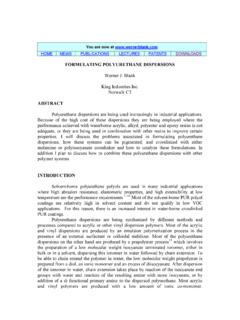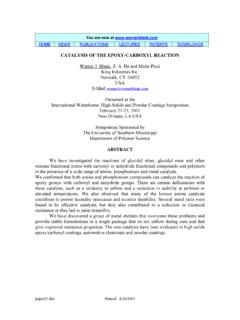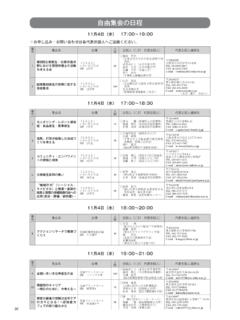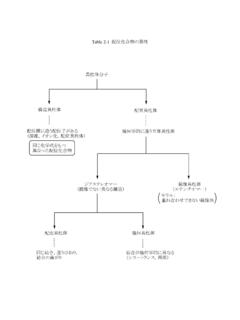Transcription of Melamine Formaldehyde Networks with Improved …
1 You are now at HOME NEWS PUBLICATIONS LECTURES PATENTS DOWNLOADS Melamine Formaldehyde Networks with Improved Chemical Resistance Blank, He, E. T. Hessell and Abramshe, King Industries Inc. Norwalk, CT. 06852 Introduction Melamine Formaldehyde resins (MFR) are used to crosslink many industrially applied coatings. Much of the MFR used in the US. are of the hexa(methoxymethyl) Melamine (HMMM) type. As reaction partners for HMMM predominantly hydroxyl or carboxyl functional resins are used. The reaction of HMMM with hydroxyl polymers is generally well understood. The reaction is specific acid catalyzed with strong acid catalysts such as sulfonic acid commonly used. The acetal linkage formed can hydrolyze under acidic conditions leading to a loss of the network structure and attack on the film. Typical acid rain conditions are sufficient to damage the coating.
2 This hydrolysis reaction is accelerated at higher temperature and increased humidity. One additional factor in the hydrolysis reaction of Melamine crosslinked films is the basicity of Melamine which leads to the absorption of acid in the film. The acid sensitivity of Melamine crosslinked coatings has become more of a problem with the introduction of high solids coatings which require higher levels of Melamine In the automotive topcoat area this problem is especially severe. Where many attempts have been made to replace Melamine crosslinking with other crosslinker. From a cost and performance standpoint Melamine crosslinker are very attractive, providing much of an incentive to find ways to improve the acid resistance. The self-condensation reaction of Melamine resins2 during overbake conditions and the ensuing embrittlement is also a result of hydrolytic instability of the crosslinks, leading to a loss of crosslinking and the formation of a self-crosslinked network.
3 A more stable link of the polymer with the Melamine resin should also reduce the loss of flexibility of Melamine crosslinked coatings on overbake. Melamine Formaldehyde chemistry offers many other alternative ways of crosslinking besides reacting with hydroxyl and carboxyl groups, HMMM can react with NH and CH reactive sites on polymers to form linkages which are potentially more resistant to hydrolysis. APPROACHES TO Improved STABILITY OF NETWORK Reduced Melamine Resin Level and Dual Cure Systems Blocked Isocyanates Ketoxime3 Malonate4 Siloxane5 Epoxy6 More Stable Crosslinks NH crosslinks Primary Carbamate7,8 Amide Urea CH crosslinks Phenolic9 Malonate blocked isocyanate10 and Acetoacetate SH Hydrophobic Backbone or Improved Hydrolytically Stable Backbone Ester free backbone12 Polyurethane with hydrophobic groups13 Acrylic polymers14 Other potential approaches Reduced solubility of melamine15 Reduced basicity of Melamine Combination with other amino resins Change in hydrolysis equilibrium Reaction of HMMM with Functional Groups Hydroxyl Groups The reaction of HMMM with hydroxyl functional polymers has been studied extensively.
4 HMMM reacts readily with hydroxyl functional compounds in the presence of an acid catalyst. This exchange reaction proceeds at room temperature. The rate of reaction is a function of the pH of the system. Reaction with water also proceeds leading to a hydrolysis of the crosslinked network. Although this reaction is reversible, subsequent demethylolation and loss of Formaldehyde leads to a permanent loss of crosslinks16. The hydrolysis reaction can also be accelerated in the presence of UV -N(CH2 OCH3)2 + ROH -N(CH2OR)2 + 2 CH3OH -N(CH2 OCH3)2 + HOH -N(CH2OH)2 + 2 CH3OH -N(CH2OH)2 -NHCH2OH + CHOH Reduced Melamine Resin Level and Dual Cure System It has been found that coating systems which utilize less than 25 % of Melamine resin generally give acceptable acid resistance and exterior durability18.
5 For the high solids polymer systems used in the US, however this level of Melamine resin is not sufficient to achieve the required nonvolatile content. Yet increasing the Melamine content has a negative impact on acid etch resistance. Every conceivable reaction mechanism has been studied as a means to improve this deficiency. Some of these approaches are being used to improve the resistance properties of Melamine crosslinked films. Stability of the Methylene or Methylene Ether Linkage Comparison of the stability of methylene bridges of different amino compounds shows that the stability is related to the basicity of the nitrogen. An increase in basicity of either nitrogen leads to a decrease in stability of the bond. The N-C linkage in methylene ether bonds (-NHCH2OR) was found 1000 times more stable19 than the ether bond under acidic pH conditions.
6 Conclusions about the stability of the methylene linkage can be drawn from the published literature on the reactions and stability of phenol, amide, urea and imidazolidinone Formaldehyde derivatives. Stability of the >N-CH2-N< Linkage Methylene derivatives are arranged in order of increased Alkyl-NH-CH2-N<( R )2 Cyclic structure Improved stability Triazine-NH-CH2-N<( R )2 -CONH-CH2-N<( R )2 sec-Amine -CONH -CH2-NH-OCR Amide Triazine-NH-CH2-NH- Triazine Melamine Triazine-NH-CH2-NHCOOR Carbamate Triazine-NH-CH2-NH-CO-R Amide Glycoluril -CH2- Glycoluril Glycoluril The stability of the >N-CH2-N< linkage increases with a decrease in the basicity of the nitrogen. Simple reaction products of Formaldehyde with primary amines are only stable in the trimeric form. Melamine Formaldehyde Mannich base reaction products with secondary amines will form by simple blending the components and will react at low temperature even in the absence of a catalyst.
7 Mannich bases of the less basic amide with a sec. amine gives Improved stability compared to the Melamine compound. The bis-amide structures are reported to be reactive at a pH of < Melamine -carbamate and also Melamine -amide products provide further improvement in resistance properties in an acid environment. Both self-condensed glycoluril and Melamine reaction products offer even further increase in acid resistance. CH- Crosslinks Malonate blocked NCO21 R-NH-CO-CH (COOR)2 + -N(CH2 OCH3)2 R-NH-CO-C (COOR)2 -N(CH2 OCH3)CH2 + CH3OH The CH groups in malonate blocked isocyanates react readily at 120 C with HMMM in the presence of a strong acid catalyst. NMR analysis confirms the presence of this crosslink. Acid resistance of this dual (malonate bl. NCO/OH/HMMM) crosslinked network is superior to a OH/HMMM network.
8 Acetoacetate R-CO-CH2 (COOR ) + -N(CH2 OCH3)2 R-CO-CH (COOR ) -N(CH2 OCH3)CH2 + CH3OH Acetoacetates and isocyanates blocked with acetoacetates also react with HMMM, but the reaction speed is slower and a cure temperature of 140 C is required for adequate cure. The increased stability22 of the linkage assures less embrittlement on overbake and better acid resistance. Phenol OHCH3 OCH2CH3 OCH2N+H+ OHCH2 OCH3CH2 NCH3OH+ Ring alkylation of phenols can either occur in the ortho or para position. This reaction produces extremely stable links which are being used in modified phenolic end group terminated epoxy resins in combination with HMMM to give Improved chemical resistance. This reaction also permits the synthesis of carboxyl functional Melamine resins23 by reacting salicylic acid with HMMM. Mercaptan RSH + >NCH2 OCH3 + >NCH2 -SR + CH3OH Reaction of HMMM with mercaptan presents an elegant way to determine the reaction mechanism of Melamine resins.
9 The mercapto linkage cannot be reprotonated and therefore the reaction does not reverse. A potential advantage in this reaction is a lower cure temperature and Improved resistance properties. Hydrophobic Backbone or Hydrolytically Stable Backbone Several approaches have been taken to improve the resistance properties of Melamine crosslinked films by increasing the steric hindrance of the ether linkage or reducing the amount of ester linkages and replacing these linkages with hydrolytically more stable urethane bonds. Although the sec. carbamate groups in urethanes are potentially reactive with Melamine resins, no publications have specifically discussed this subject. The presence of hydrophobic side chains in polyurethanes has a significant effect on the acid resistance in the film. Indications are that the large differences in solubility parameter between hydrophobic side chains and the urethane backbone causes phase separation and an enrichment of the hydrophobic chains on the surface, decreasing the wetting of the surface thereby increasing the acid resistance.
10 Other Approaches Surface analysis of crosslinked coatings exposed to acid rain show surface leaching of Melamine and pitting to be the primary mode of deterioration. The probable mechanism is presumably the hydrolysis of the ether bonds between polymer and Melamine resin, leading to clusters of Melamine self-condensate on the surface, which in time will further degrade or leach from the surface. One publication claims further hydrolysis of Melamine to ammeline and ammelide24. This mechanism might apply to laboratory studies, but it is questionable under natural exposure conditions if the solubility of Melamine might not dominate the surface loss. The basic nature of Melamine crosslinked films permits the formation of acid / base complexes with reduced water solubility. One of the factors contributing to the acid sensitivity problem of Melamine crosslinked coatings is the basic nature of Melamine .
